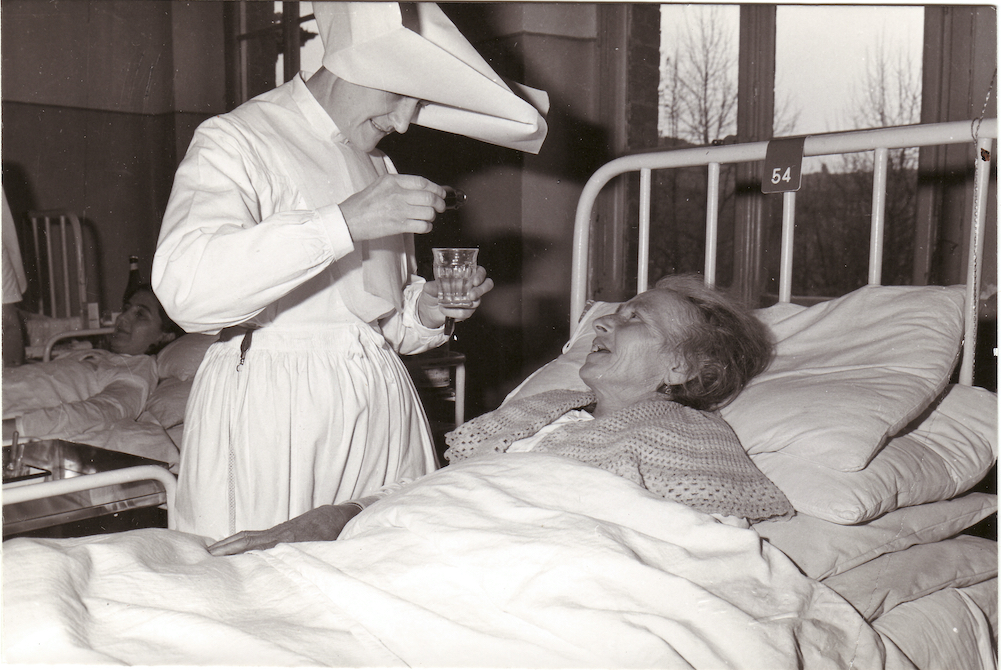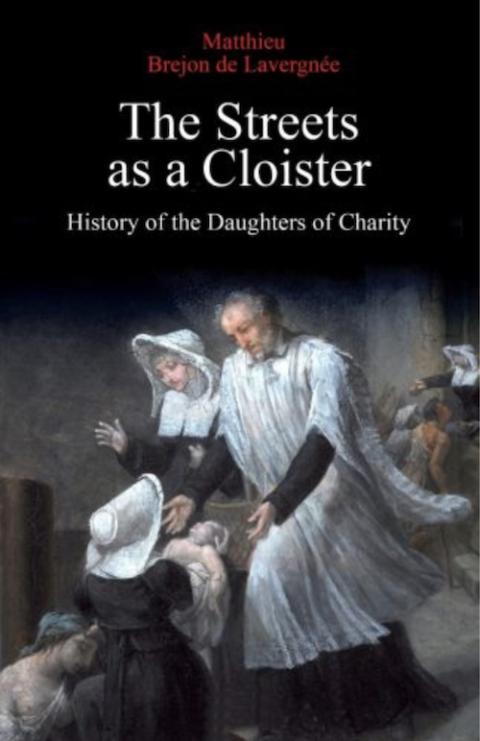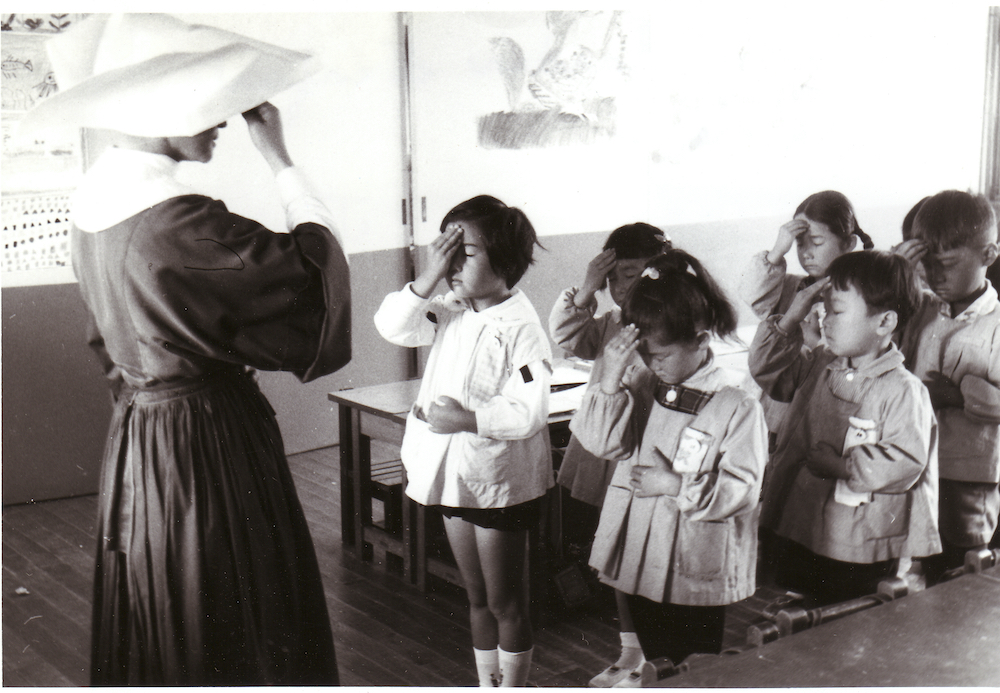
A Daughter of Charity tends to a sick person in Italy in the 1950s. (©Archives of the Daughters of Charity, Paris)
When the Daughters of Charity asked Professor Matthieu Brejon de Lavergnée to write their history, they were eager to let the world know how one of the most famous religious communities — and the biggest to this day, Brejon says — was created in 17th-century France.
Brejon did his doctoral work at the Sorbonne on the Society of St. Vincent de Paul, founded by Blessed Frédéric Ozanam, and on social Catholicism. This group of laypeople, which is still very active today, bears the name of Vincent de Paul, as he was perceived as a model of charity. St. Vincent is the priest who cofounded the Daughters of Charity with St. Louise de Marillac. The Daughters of Charity opened their archives, including private ones, for him to do his research.
Brejon is now a professor of history and the Dennis H. Holtschneider Chair at DePaul University in Chicago. He is the author of The Streets as a Cloister: History of the Daughters of Charity, which gives a lively account of the first two centuries of existence of this original community.
The second volume, Le temps des cornettes in French, covers the 19th and 20th centuries and will be published in English in late 2021 or early 2022.
There are now about 15,000 Daughters of Charity in almost 100 countries. Most of them are in still Europe and America, but growing communities are in Africa and Asia.
Advertisement
GSR: Why did the Daughters of Charity ask you to write their history?
Brejon: They wanted it to be known, especially since most sisters in Europe are now getting older, aged between 60 and 80. Their communities are growing in the Global South, where members are 40 to 60 years old. They were keen to transmit a legacy to a community that is changing, not unlike the Catholic Church, and whose role is declining in most Western countries.
I remember that I took part in one training session and found it fascinating: There were a lot of sisters from Africa. These are people who have experienced the reality of war, which we haven't in recent Europe. They know what real poverty is like. Most African countries do not have a welfare state like we do in Europe, so they can relate to the times when Daughters of Charity started their mission in France in the 17th century.
The Catholic Church has always institutionalized charitable work and tended to the most vulnerable. In earlier times, this was the role of deacons and deaconesses, then came specific religious congregations during the Middle Ages. In Europe, sisters have long been in charge of a large part of the education and health of the population. Little by little, governments have taken over these basic public services, making them more professional.
What led Vincent de Paul and Louise de Marillac to create this community?
Vincent de Paul saw how poor and sick people were cared for by religious orders welcoming pilgrims to Rome. He also had in mind Christ's words: "Whatsoever you do for the least of these little ones, so you do unto me" (Matthew 25:40).
To him, taking care of the poor meant meeting God because, as he said to the Daughters of Charity: "If you must leave prayer to attend the sick, leave it, and as you leave God in prayer, you will find God with the sick."

Cover art for "The Streets as a Cloister: History of the Daughters of Charity" by Matthieu Brejon de Lavergnée (New City Press)
He was, however, very aware that taking care of people in need should not be done at the expense of prayer and spiritual life.
In 1617, Vincent de Paul founded the first Confraternity of Charity, whose members were quickly named "Ladies of Charity."
In my book, I recall the story of Vincent de Paul saying Mass that same year in the little town of Châtillon, France. He was about to preach when he heard that a sick person needed help. He gave a different sermon than the one he had prepared, insisting on charity toward those in need and, after Mass, he organized for people to go and visit this sick person.
Louise de Marillac chose Vincent de Paul as her spiritual director in 1625. A widow, mother of a son, she had always wanted to become a nun and serve the poor. She encouraged him to set up more confraternities.
They both came to think it would be a good idea to recruit young peasant girls who could visit the homes of people in need, something the Ladies of Charity would not do themselves and that cloistered nuns could not do either, since they were not allowed to leave the convent.
At the time, especially after the Council of Trent, religious life for women could mostly be contemplative and behind enclosure. Besides, when a woman entered religious life, she had to bring money to the convent the same way she had to have a dowry to get married. Poor girls were not easily accepted except as "converse," servants to other members of the community.
Louise de Marillac imagined a community where young peasant girls would live and pray together, but their main task would be to go and assist families in the country or in hospitals.
The first company of Daughters of Charity was created in 1633. Women who joined these groups were not nuns, strictly speaking, since they did not pronounce perpetual vows but yearly vows, which they renewed. No enclosure for them, no habit: They wore their everyday clothes, the same as those of the people they visited. This included a veil that slowly was put up around their heads to become a cornette, a headdress that made the sisters famous from the 18th century to the 1950s.
To this day, they do not belong to a religious congregation, but form a society of apostolic life.

Children make the sign of the cross at a school run by Daughters of Charity in Japan in the 1950s. (©Archives of the Daughters of Charity, Paris)
How did church authorities see these new groups?
This movement started not so long after the Council of Trent in the 16th century, a council called to counter the Reformation and renew the spiritual life. The council decided to reform religious life with more discipline. The enclosure was reestablished, stricter for women than for men. But at the same time, questions were raised about practicing charity. There was also a movement within the church that wanted to evangelize poor people and take care of victims of poverty and wars. The question was: How to be a missionary and a nun at the same time?
As mother superior of the community from 1633 to her death in 1660, Louise de Marillac was instrumental in implementing the French school of spirituality. She insisted on Mary's and Jesus' incarnation to explain they were models of life we should lead on Earth.
At a time when religious congregations were under the control of a bishop, the independence of the Daughters of Charity was guaranteed. There were two people at the head of the confraternity: a priest, called a Lazarist, or a Vincentian, as we say today, and a mother superior. Church authorities were happy to see the work done by these young women even though they were a little jealous of their popularity and independence. Helping the poor was a tradition in the Catholic Church, but the way Daughters of Charity did it was new.
These companies' work was so appreciated that more of them were created in other regions. They also went to Poland at the request of the queen, a former Lady of Charity in Paris. But their successful worldwide expansion, including the U.S., took place during the 19th century, a journey that will be told in my next book.
In what way did they innovate?
They made it simpler to assist people. Their work was partly financed by wealthy people, including Ladies of Charity. Some of them also financed the building of a hospital with lodgings for a community of Daughters of Charity.
In the country, they would go and see sick people, bring food and medicine and talk about God, seeing their work as a mission to show God's love. In a city like Paris, they set up soup kitchens. These tasks were never easy: In the country, they had to walk miles to go to isolated houses. In big cities, people who lined up to get food could be violent. This reached a point when the Paris authorities had to issue a decree forbidding anyone to hit any of these women, which means it must have happened!
The Daughters of Charity also set up schools, mainly for girls, and homes for orphaned children. Religious education was an essential part of education.
They were very innovative in the way they managed to be very pious and pray often. At the same time, they were out in the field, convinced that God is present with poor people.







